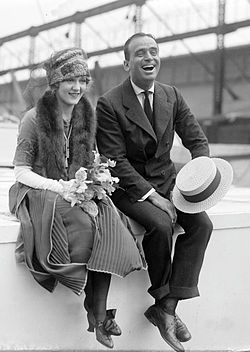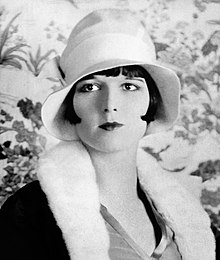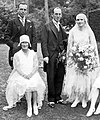1920s in Western fashion: Difference between revisions
| Line 9: | Line 9: | ||
After [[World War I]], America entered a prosperous era and, as a result of its role in the war, came out onto the world stage. Social customs and morals were relaxed in the optimism brought on by the end of the war and the booming of the [[stock market]]. Women were entering the workforce in record numbers. The nationwide [[Prohibition in the United States|prohibition]] on alcohol was ignored by many. There was a revolution in almost every sphere of human activity{{Fact|date=June 2009}}, and fashion was no exception. aaoaAHDJKFBNKMVSKNSDJKNMGVSDFMNVLGMFADNBV NBF DJFVNJFRVMVMJVBJ APPLE |
After [[World War I]], America entered a prosperous era and, as a result of its role in the war, came out onto the world stage. Social customs and morals were relaxed in the optimism brought on by the end of the war and the booming of the [[stock market]]. Women were entering the workforce in record numbers. The nationwide [[Prohibition in the United States|prohibition]] on alcohol was ignored by many. There was a revolution in almost every sphere of human activity{{Fact|date=June 2009}}, and fashion was no exception. aaoaAHDJKFBNKMVSKNSDJKNMGVSDFMNVLGMFADNBV NBF DJFVNJFRVMVMJVBJ APPLE |
||
Clothing changed with women's changing roles in modern society, particularly with the idea of |
Clothing changed with women's changing roles in modern society, particularly with the idea of CHEESEBURGERS. Although society matrons of a certain age continued to wear conservative dresses, forward-looking and younger women now made [[Sportswear (fashion)|sportswear]] into the greatest change in post-war fashion. The tubular dresses of the 'teens had evolved into a similar silhouette that now sported shorter skirts with pleats, gathers, or slits to allow motion. Undergarments began to transform after World War I to conform to the ideals of a flatter chest and more boyish figure. The corset was diminishing and the bandeau, flattening style was prevalent in the early 1920s. During the mid-twenties all-in-one lingerie became popular, leaving behind the corset and moving into the curvier brassiere era of the 1930s. |
||
[[File:Bundesarchiv Bild 102-00140A, Elisabeth Gabriele in Bayern.jpg|thumb|[[Elisabeth Gabriele of Bavaria]], Queen of Belgium, 1920]] |
[[File:Bundesarchiv Bild 102-00140A, Elisabeth Gabriele in Bayern.jpg|thumb|[[Elisabeth Gabriele of Bavaria]], Queen of Belgium, 1920]] |
||
[[Image:Louise Brooks detail ggbain.32453u.jpg|thumb|right|Actress [[Louise Brooks]] in 1927, wearing a [[cloche hat]]]] |
[[Image:Louise Brooks detail ggbain.32453u.jpg|thumb|right|Actress [[Louise Brooks]] in 1927, wearing a [[cloche hat]]]] |
||
| Line 64: | Line 64: | ||
#[[:Image:TheSpirellaMagazineMAY1928 - 73 .png|May 1928, abdomen and curves]]. After many years of a "stovepipe" silhouette, "natural" curves were beginning to reappear.<ref>[[:image:TheSpirellaMagazineMAY1928 - 72.png|The Spirella Magazine]]</ref> |
#[[:Image:TheSpirellaMagazineMAY1928 - 73 .png|May 1928, abdomen and curves]]. After many years of a "stovepipe" silhouette, "natural" curves were beginning to reappear.<ref>[[:image:TheSpirellaMagazineMAY1928 - 72.png|The Spirella Magazine]]</ref> |
||
#[[:Image:CoupleOnCruiseShip1929 detail.jpg|Knee-length]], pleated skirts and dropped waists were still popular as everyday clothes in 1929, though Paris designers were already showing longer skirts and higher waistlines. |
#[[:Image:CoupleOnCruiseShip1929 detail.jpg|Knee-length]], pleated skirts and dropped waists were still popular as everyday clothes in 1929, though Paris designers were already showing longer skirts and higher waistlines. |
||
#[[:Image:Bridesmaids1929.jpg|Bridesmaids]] gowns of 1929 have knee-length underskirts and longer, sheer over skirts, foreshadowing the trend toward longer skirts. Minnesota, |
#[[:Image:Bridesmaids1929.jpg|Bridesmaids]] gowns of 1929 have knee-length underskirts and longer, sheer over skirts, foreshadowing the trend toward longer skirts. Minnesota, 1929BFN |
||
==Menswear== |
==Menswear== |
||
Revision as of 18:20, 3 December 2010
This article includes a list of references, related reading, or external links, but its sources remain unclear because it lacks inline citations. (June 2009) |

The 1920s is the decade in which fashion entered the modern era. It was the decade in which women first liberated themselves from constricting fashions and began to wear more comfortable clothes (such as short skirts or trousers). Men likewise abandoned overly formal clothes and began to wear sport clothes for the first time. The suits men wear today are still based, for the most part, on those men wore in the late 1920s.
The 1920s are characterized by two distinct periods of fashion. In the early 1920s change progressed slowly, as many were reluctant to adopt new styles. From 1925, the public passionately embraced the styles associated with the Roaring Twenties. These styles continue to characterize fashion until early in 1932.
Womenswear

After World War I, America entered a prosperous era and, as a result of its role in the war, came out onto the world stage. Social customs and morals were relaxed in the optimism brought on by the end of the war and the booming of the stock market. Women were entering the workforce in record numbers. The nationwide prohibition on alcohol was ignored by many. There was a revolution in almost every sphere of human activity[citation needed], and fashion was no exception. aaoaAHDJKFBNKMVSKNSDJKNMGVSDFMNVLGMFADNBV NBF DJFVNJFRVMVMJVBJ APPLE
Clothing changed with women's changing roles in modern society, particularly with the idea of CHEESEBURGERS. Although society matrons of a certain age continued to wear conservative dresses, forward-looking and younger women now made sportswear into the greatest change in post-war fashion. The tubular dresses of the 'teens had evolved into a similar silhouette that now sported shorter skirts with pleats, gathers, or slits to allow motion. Undergarments began to transform after World War I to conform to the ideals of a flatter chest and more boyish figure. The corset was diminishing and the bandeau, flattening style was prevalent in the early 1920s. During the mid-twenties all-in-one lingerie became popular, leaving behind the corset and moving into the curvier brassiere era of the 1930s.


The women's rights movement had a strong effect on women's sexual fashions. Most importantly, the confining corset was discarded, as undergarments changed to suit the new fashions in this decade. Instead of drawers and knickers, women now wore panties, which were more comfortable. The chemise or camisole was employed in place of the corset. During the early part of the decade, chemises paired with bloomers kept a woman covered beneath her outer garments. For the first time in centuries, women's legs were seen with hemlines rising to the knee and dresses becoming more fitted. A more masculine look became popular, including flattened breasts and hips, short hairstyles such as the bob cut, Eton Crop and the Marcel Wave. One of the first women to wear trousers, cut her hair and reject the corset was Coco Chanel. Probably the most influential woman in fashion of the 20th century, Coco Chanel did much to further the emancipation and freedom of women's fashion.
The straight-line chemise topped by the close-fitting cloche hat became the uniform of the day. Women "bobbed," or cut, their hair short to fit under the popular hats, a radical move in the beginning, but standard by the end of the decade. Low-waisted dresses with fullness at the hemline allowed women to kick up their heels literally in new dances like the Charleston.
Jean Patou, a new designer on the French scene, began making two-piece sweater and skirt outfits in luxurious wool jersey and had an instant hit for his morning dresses and sports suits. American women embraced the clothes of the designer as perfect for their increasingly active lifestyles.
By the end of the Twenties, Elsa Schiaparelli stepped onto the stage to represent a younger generation. She combined the idea of classic design from the Greeks and Romans (think "tunic") with the modern imperative for freedom of movement. Schiaparelli wrote that the ancient Greeks "gave to their goddesses ... the serenity of perfection and the fabulous appearance of freedom." Her own interpretation produced gowns of elegant simplicity. Departing from the chemise, her clothes returned to an awareness of the body beneath the gown.
In the world of art, fashion was being influenced heavily on art movements such as surrealism. After World War I, popular art saw a slow transition from the lush, curvilinear abstractions of art nouveau decoration to the more mechanized, smooth, and geometric forms of art deco. Elsa Schiaparelli is one key Italian designer of this decade who was heavily influenced by the "beyond the real" art and incorporated it into her designs.
During the Twenties, Tirocchi clients asked for designs by known designers rather than work with Madame Tirocchi directly to create gowns for them. Most of these dresses were copies produced by New York fashion houses like Harry Angelo and Maginnis & Thomas, although some came from the New York City department stores B. Altman and Lord and Taylor.
Some Tirocchi clients purchased designs by old favorites from the 'Teens, like Agnes, Callot Soeurs, Jeanne Lanvin, Poiret, and others. However, they bought a lot from the new designers Chanel and Patou (who was the special favorite of the young set).
The technological development of new fabrics and new closures in clothing were affecting fashions of the 20s. Natural fabrics such as cotton and wool were the abundant fabrics of the decade. Silk was highly desired for its luxurious qualities, but the limited supply made it expensive. In the late 19th century, "artificial silk" was first made from a solution of cellulose in France. After being patented in the United States, the first American plant began production of this new fabric in 1910; this fiber became known as rayon. Rayon stockings became popular in the decade as a substitute for silk stockings. Rayon was also used in some undergarments. Many garments before the 1920s were fastened with buttons and lacing, however, during this decade, the development of varieties of metal hooks and eyes meant that there were easier means of fastening clothing shut. Hooks and eyes, buttons, zippers or snaps were all utilized to fasten clothing.
Style gallery 1920–25
-
1 - 1920
-
2 - 1921
-
3 - 1922
-
4 - 1923
-
5 - 1924
-
6 - 1925
-
70 - 1920s
- 1920 summer sport suit.
- The forehead was usually covered in the 1920s, here by a hat reaching to the eyebrows.
- 1922 Rolled stockings.
- Dress of 1923 has a dropped waist and width at the hips.
- Teenage girls in Minnesota wear breeches and riding boots with men's neckties, 1924.
- By 1925, skirts ended just below the knee. Tunic-tops and sweaters reaching to the hips were popular.
Style gallery 1926–29
-
1 – 1926
-
2 – 1926
-
3 – 1926
-
4 – 1926
-
5 – 1927
-
6 – May 1928
-
7 – 1929
-
8 – 1929
- Actress Aileen Pringle wears a cloche hat and boldly patterned coat, 1926.
- Actress Alice Joyce in a straight evening dress with a sheer beaded overdress, 1926.
- This 1926 painting shows the mid-decade silhouette at its simplest: languid pose, bobbed hair, knee-length dress with dropped waist.
- Evening dresses of 1926 featured simple lines and emphasis at the hips. Hair is parted to one side and worn in soft waves. Portrait of Alisa Mellon Bruce, 1926.
- Designers used multiple hemlines (here, tiers of ruffles) to accustom the eye to longer skirts. This gown foreshadows the higher waist and feminine look that spread to everyday fashion by the early 1930s.
- May 1928, abdomen and curves. After many years of a "stovepipe" silhouette, "natural" curves were beginning to reappear.[1]
- Knee-length, pleated skirts and dropped waists were still popular as everyday clothes in 1929, though Paris designers were already showing longer skirts and higher waistlines.
- Bridesmaids gowns of 1929 have knee-length underskirts and longer, sheer over skirts, foreshadowing the trend toward longer skirts. Minnesota, 1929BFN
Menswear

In menswear there were two distinct periods in the 1920s. Throughout the decade, men wore short suit jackets, the old long jackets (on morning suits and tail-coats) being used merely for formal occasions. In the early twenties, men's fashion was characterized by extremely high waisted jackets, often worn with belts. Lapels on suit jackets were not very wide as they tended to be buttoned up high. (This style of jacket seems to have been greatly influenced by the uniforms worn by the military during the First World War.) Trousers were relatively narrow and straight (never tapered) and they were worn rather short so that a man's socks often showed. Trousers also began to be worn cuffed at the bottom at this time.
By 1925, wider trousers commonly known as "Oxford Bags" came into fashion, while suit jackets returned to a normal waist and lapels became wider and were often worn peaked. Loose fitting sleeves (without a taper) also began to be worn during this period. During the late 1920s, double breasted vests, often worn with a single breasted jacket, also became quite fashionable. During the 1920s, men had a variety of sport clothes available to them, including sweaters and short trousers, commonly known as knickers. For formal occasions in the daytime, a morning suit was usually worn. For evening wear men preferred the short tuxedo to the tail-coat, which was now seen as rather old-fashioned and snobby.
Men's hats
Men's hats were usually worn depending on their class, with upper class citizens usually wearing top hats or a homburg hat. Middle class men wore either a fedora or a trilby hat, and working-class men wore a standard flat cap or no hat at all.
Style gallery
-
1 - c. 1920
-
2 - 1923
-
3 - 1924
-
4 - 1929
-
5 - 1920s
-
6 - 1927
- Photographer Clarence Hudson White, c. 1920.
- Politician William J. Fields wears an overcoat and soft-crowned hat with a bow tie, December 1923.
- Publisher Edward Beale McLean wears a three-piece striped suit with a spread-collar shirt, 1924.
- Men wear morning dress and spats in this 1929 wedding photo.
- Ronald Reagan as a teenager wearing knickerbockers.
- Man in 1927 wearing a Panama hat and buttoned waistcoat.
Work clothes
-
1922
Children's fashion
-
1 – 1921
-
2 – 1923
-
3 – 1925
-
4 – 1927
-
5 -01920s
- Roller-skater, Mississippi, 1921
- Knee-length dress worn with anklets and Mary Janes, 1923.
- Children's fashion, Germany, 1925
- Two-year-old Paulina, with her mother Alice Roosevelt Longworth, wears a winter costume of coat and trousers, 1927.
See also
Notes
References and further reading
- Arnold, Janet: Patterns of Fashion 2: Englishwomen's Dresses and Their Construction C.1860–1940, Wace 1966, Macmillan 1972. Revised metric edition, Drama Books 1977. ISBN 0-89676-027-8
- Black, J. Anderson, and Madge Garland, A History of Fashion, New York, Morrow, 1975
- Boucher, François: 20,000 Years of Fashion, Harry Abrams, 1966.
- Laver, James: The Concise History of Costume and Fashion, Abrams, 1979.
- Nunn, Joan: Fashion in Costume, 1200–2000, 2nd edition, A & C Black (Publishers) Ltd; Chicago: New Amsterdam Books, 2000. (Excerpts online at The Victorian Web)
- Russell, Douglas A. " Costume History and Style" Stanford University, 1983.
- Steele, Valerie: Paris Fashion: A Cultural History, Oxford University Press, 1988, ISBN 0-19-504465-7
- Steele, Valerie: The Corset, Yale University Press, 2001
- The Spirella Magazine; MAY 1928
- Children's fashion of the 1920s

























